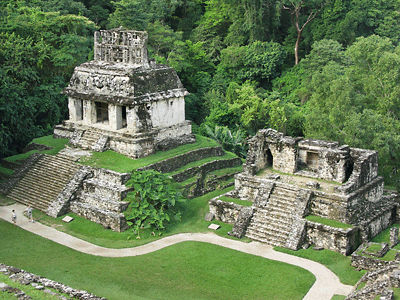Current Events Lesson Plan: September 1-7, 2016
Current Event: The Maya Snake Dynasty
Archaeologists recently discovered a large Mayan tomb that was decorated with stone panels that told the story of the rise and fall of powerful kings known as the “Snake Dynasty.” The 1,300-year-old tomb was discovered at Xunantunich, an important Maya ceremonial and administrative city on the Mopan River in what is now Belize. Inside the tomb, archaeologists found the skeleton of a male, probably between 25 and 30 years of age. Grave goods around the skeleton indicated that the person buried was of high social status. But the most interesting artifacts in the tomb were a pair of stone panels engraved with Maya hieroglyphics. Scholars believe the panels were ordered by K’an II, the king of Caracol known as the Snake Lord, to commemorate his military victory over Naranjo, just west of Xunantunich, around A.D. 642. The panels describe how the defeated lord of Naranjo participated in a ceremonial ball game before being sacrificed to the gods. The panels go on to record details of a tumultuous period for the conquering family—the Snake Dynasty—marked by deaths, fights over royal succession, and marriages of alliance with royals from nearby cities. By about A.D. 680, the people of Naranjo had rebelled against and defeated the Snake Dynasty of Caracol. Xunantunich and the surrounding cities went into a sudden decline about A.D. 900, marking the end of the Classic Period of Maya civilization. Eventually, the cities were abandoned and overgrown with forest.

Ruins of an ancient Maya temple stand at Palenque in the state of Chiapas. The temple was built about A.D. 650, during a period when great indigenous (native) civilizations thrived in Mexico. (© Ales Liska, Shutterstock)
Objective:
The Maya were an American Indian people who developed a magnificent civilization in Central America and south Mexico. The Maya produced remarkable architecture, painting, pottery, and sculpture. They made great advancements in astronomy and mathematics and developed an accurate yearly calendar. They were one of the first peoples in the Western Hemisphere to develop an advanced form of writing. The Maya lived in an area of about 120,000 square miles (311,000 square kilometers). Today, their territory is divided among Mexico and several Central American countries. The Maya civilization was at its peak from about A.D. 250 to 900. During that time, known as the Classic Period, it was centered in the tropical rain forest of the lowlands of what is now northern Guatemala. By about 900, most of the Maya abandoned the Guatemalan lowlands and moved to areas to the north and south. In the early 1500′s, Spanish conquerors invaded the Maya territories. By the mid-1500′s, they had overcome almost all the Maya. The Behind the Headlines news story and related World Book articles explore the Maya and other ancient civilizations.
Words to know:
Discussion Topics:
1. The Maya lived in Mexico and Central America. Ask your students to name the countries of Central America. (The seven Central American countries are Belize, Costa Rica, El Salvador, Guatemala, Honduras, Nicaragua, and Panama.)
2. The Maya developed one of the most important American Indian cultures in Latin America. Ask your students if they can name other important American Indian cultures in Latin America. (They might say Aztec, Inca, Toltec.) Ask your students if they can name other ancient civilizations. (They might say Assyria, Babylon, Egypt, Greece, Persia, Rome.)
3. Archaeology is the scientific study of the remains of past human cultures. Have your students debate the topic, “It is important to learn about people from the past.”
4. Ask your students to use World Book’s Timelines feature to view or add to the History of the Maya timeline. (Students may wish to use World Book’s Maya article for help.)


